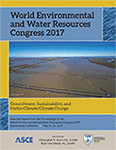Assessing the Robustness of Snow-Based Drought Indicators in the Upper Colorado River Basin under Future Climate Change
Publication: World Environmental and Water Resources Congress 2017
Abstract
The Colorado River is a critical water resource that has enabled the development of the southwestern U.S. About 85% of the river’s annual runoff volume of originates in the northern half of the watershed, the Upper Colorado River Basin (UCRB). Recently, basin-wide water demand has nearly eclipsed supplies, yet population and associated water demands are projected to significantly increase, with the majority of new demand coming from the municipal and industrial sectors. Simultaneously, climate change is expected to cause earlier snowmelt and peak runoff. With these compounding stressors, continued skillful forecasting of warm-season water resources will be critical to mitigate changing conditions. Snow water equivalent (SWE) at key dates during the late winter and spring (e.g., April 1) is widely used in such forecasting because it represents the major water storage term in a snowmelt-dominated system like the UCRB. Snowfall and seasonal snowpacks are likely to be significantly affected by warming temperatures, portending a future where snow may not be as robust an indicator of water supply and drought. Thus, this research addresses the question: How are the key indicators of drought in the UCRB likely to change under a future climate? We seek to assess changes in drought predictability under future climate using downscaled hydrologic simulations driven by CMIP5 ensemble mid-century (2045-2055) projections. We evaluate historical hydrologic simulations from the variable infiltration capacity (VIC) model against observations to understand model performance and then applied the hydrologic framework to explore changes in future skill. We find a strong predictive relationship between historical April 1 SWE and streamflow for the May-July period (R=0.82), with similar skill for the model (R=0.88). Despite a persistent negative bias between simulated and observed April SWE (31%), simulated SWE is strongly correlated with observed (R=0.93) indicating the utility of the model to characterize hydrologic behavior and a viable tool to assess future predictability. Mid-century projected streamflows are modestly reduced on average (6.9%), with key reductions occurring during the warm season (13.9% reduced) and peak flow occurring a full month earlier than historic, presenting important challenges for water managers. Finally, the strength of the predictive relationship between SWE and warm-season flow is notably diminished under future climate (R=0.77) and is consistently diminished during historical and future drought years relative to non-drought years. These results indicate an appreciable challenge for seasonal forecasting to mitigate projected drier conditions and prompting our recommendation for water managers to explore other non-snow-based sources of predictability.
Get full access to this article
View all available purchase options and get full access to this chapter.
Information & Authors
Information
Published In
Copyright
© 2017 American Society of Civil Engineers.
History
Published online: May 18, 2017
Authors
Metrics & Citations
Metrics
Citations
Download citation
If you have the appropriate software installed, you can download article citation data to the citation manager of your choice. Simply select your manager software from the list below and click Download.
